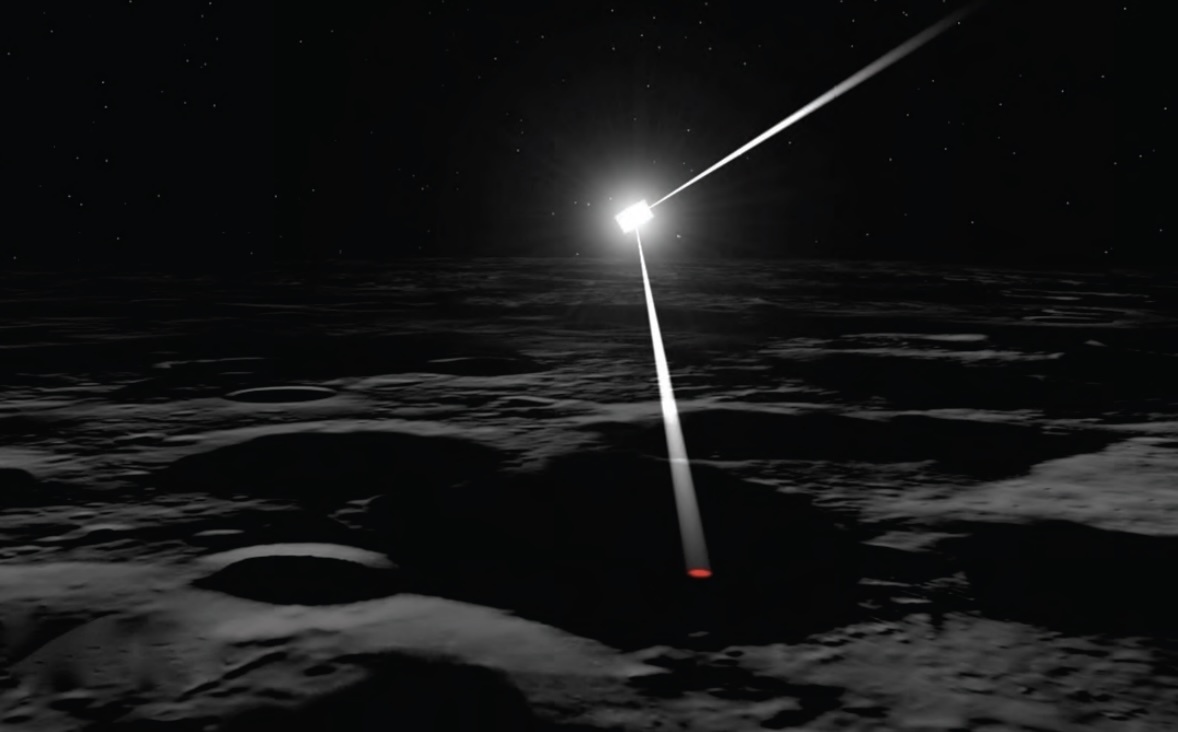

Illustration of Mercury Scout illuminating a crater
Solar sails rely upon pressure exerted by sunlight on large surfaces. Get the sail closer to the Sun and not surprisingly efficiency increases. A proposed new mission called Mercury Scout aims to take advantage of this to explore Mercury. The mission will map the Mercurian surface down to a resolution of 1 meter and, using the highly reflective sail surface to illuminate shadowed craters, could hunt for water deposits.
Unlike conventional rocket engines that require fuel which itself adds weight and subsequently requires more fuel, solar sails are far more efficient. Light falling upon the sail can propel a prob across space. It’s a fascinating concept that goes back to the 1600’s when Johannes Kepler suggested the idea to Galileo Galilei. It wasn’t until the beginning of the 21st Century that the Planetary Society created the Cosmos 1 solar sail spacecraft. It launched in June 2005 but a failure meant it never reached orbit. The first successfully launched solar sail was Ikaros, launched by the Japanese Aerospace Exploration Agency it superbly demonstrated the feasibility of the technology.


It has been known since 1905 that light is made up of tiny little particles known as photons. They don’t have any mass but while travelling through space, they do have momentum. When a tennis ball hits a racket, it bounces off the strings and some of the ball’s momentum is transferred to the racket. In a very similar way, photons of light hitting a solar sail transfer some of their momentum to the sail giving it a small push. More photons hitting the sail give another small push and as they slowly build up, the spacecraft slowly accelerates.
Mercury Scout will take advantage of the solar sail idea as its main propulsion once it has reached Earth orbit. The main objectives for the mission are to map out the mineral distribution on the surface, high resolution imaging down to 1 meter resolution and identification of ice deposits in permanently shadowed craters. The solar sail was chosen because it offers significant technical and financial benefits lowering overall cost and reducing transit time to Mercury.
To propel the Mercury Scout module, the sail will be around 2500 square meters and 2.5 microns thick. The material is aluminised CP1 which is similar to that used in the heat shield of the James Webb Space Telescope. The sails four separate quadrants unfurl along carbon fibre supports and will get to Mercury in an expected 3.8 years. On arrival it will transfer into a polar orbit and then spend another 176 days mapping the entire surface.
To enable the entire planet to be mapped the the orbit will have to be maintained by adjusting the angle of the sail. In the same way the captain of a sailing ship can sail against, or sometimes into wind by adjusting sail angle and position so the solar sail can be used to generate thrust in the required direction.
Unlike other more traditional rocket engines whose life is usually limited to fuel availability, the solar sail is limited by degradation in sail material. Its life expectancy is around 10 years. Additional coatings are being explored to see if the life of the sail can be extended further.
Source : MERCURY SCOUT: A SOLAR SAIL MISSION TO THE INNERMOST PLANET
Dubbed CADRE, a trio of lunar rovers are set to demonstrate an autonomous exploration capability…
Astronomers have identified sulfur as a potentially crucial indicator in narrowing the search for life…
Biologists identified a series of "hard steps" on the journey from abiogenesis - that life…
The supermassive black hole at the center of our Milky Way galaxy may not be…
For those who missed the memo, UFOs (Unidentified Flying Objects) are now called UAPs (Unidentified…
The Phoenix Cluster is one of the most massive galaxy clusters known. Astronomers have identified…